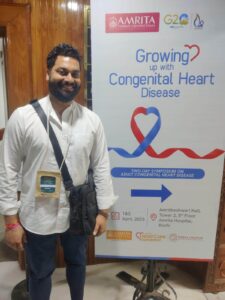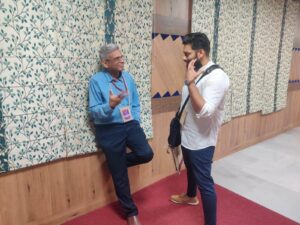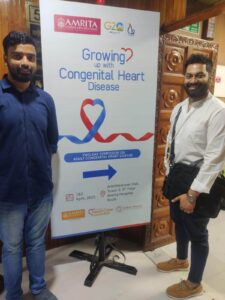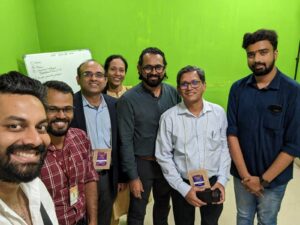Published June 14, 2023
When Kartheek Battepati offered to volunteer for Children’s HeartLink during a visit home to India, he didn’t expect to be welcomed into the world of pediatric cardiology. He soon found himself meeting leaders in heart care, attending the Adult Congenital Heart Disease (ACHD) symposium, holding a 3D-printed heart in his hands and experiencing the incredible potential of virtual reality (VR) applications for the medical field.

“When I saw what they were doing there, it blew me away,” Kartheek said. “Now I understand why Mark Zuckerburg is going all in on the metaverse. This is world-changing technology.”
His story unfolded in a way that proves you never know where opportunities may lead you next. Kartheek’s story gives us a glimpse inside the pediatric cardiac world and revolutionary technology being used at our first-ever Children‘s HeartLink Center of Excellence in Kochi, India.
A LinkedIn interaction opens doors for a corporate volunteer
Kartheek, who lives in the United States, was on a yearly visit to see family in Bangalore when he saw our LinkedIn post on April 3, 2023 about India Giving Day.
He knew of Children’s HeartLink because he had participated in a corporate volunteer program with his employer Medtronic. He won a competitive role on a project team tasked with choosing a Learning Management System that would allow Children’s HeartLink to implement a blended learning model and expand virtual training abilities.
He also knew Children’s HeartLink had a Center of Excellence near him, so he offered to volunteer.
“I thought I’d go to visit the Bangalore hospital,” he said. “Maybe help with business process optimization or project management. Something non-medical.”
But Kartheek was put in touch with Veera Rajasekhar, the Children’s HeartLink country director in India, who had other ideas in mind.
“I saw a great opportunity for him to be present at a conference hosted by our Center of Excellence in the region,” Veera said, “not only to witness professional discussions but also to experience patient stories. Since he was from a tech background, I also felt that he would truly appreciate the way in which technology has been leveraged to improve patient care and outcomes.”
Kartheek soon found himself on a one-hour flight south to Kochi, where the Adult Congenital Heart Disease (ACHD) symposium was being held.
Save Children’s Lives. Donate Today.

Inside the ACHD symposium
Kartheek is not a medical professional, but he does work in the medical device industry. While he describes many of the symposium’s medical topics as “over his head,” he could follow the methodologies described in presentations because of trials and studies he’s encountered through his job.
“I know a little about CHD [congenital heart disease] and Children’s HeartLink, but it’s all through reading,” he said. “I’ve never performed surgery or been in an operating room. I’ve never held scissors to cut someone open. There were very few non-medical people there, and me getting invited was a big deal.”
Kartheek observed presentations from the last row of the audience and noted how Dr. Krishna Kumar, head of pediatric cardiology at Amrita Hospitals in Kochi and one of the event organizers, would ask participants for their input throughout presentations. At first, he was surprised to see Dr. Kumar encouraging doctors, students and presenters to have good conflict in their conversations.
Kartheek said this communication style contributed to the collaborative atmosphere of the symposium.
“Once I understood the game plan, it all made sense,” Kartheek said. “They were teaching the students that there’s not just one right way to do anything. The end result is what we are judged on, but there are multiple ways to get to the end point.”

3D hearts, VR and the future of medicine
After attending the ACHD symposium, he visited Children’s HeartLink Center of Excellence Amrita Hospital in Kochi where he was given a tour of the 3D printing and virtual reality (VR) labs by Harikrishnan “Hari” AM. Hari is a heart warrior. He had his congenital heart defect repaired by Dr. Mahesh Kappanayil, a cardiologist at Amrita Hospital in Kochi. He now works at the hospital as the 3D Engineer at the 3D printing and XR [extended reality] laboratory and has become an advocate for all children with heart disease.
Hari showed Kartheek how hearts can be printed using different materials to aid pediatric cardiac care teams in serving children with heart disease. Some are incredibly realistic – Kartheek compared these to jellyfish and said it felt almost too much like a real heart – while others, which he got to hold in his hands, resemble a silicone toy for a child.
“They can print a heart exactly the way it is and look at exactly which point the surgery needs to be done,” Kartheek said. “You look at a model of a heart, an exact-sized model, and then discuss with other doctors about incisions.”
With 3D printing, surgeons can understand a heart’s specific defect and create a plan for repairing it.
Hari and Kartheek next visited the VR lab with Dr. Mahesh. Until that moment, Kartheek had only worn VR goggles to watch movies or play video games.
“I thought that’s what these gadgets are,” he said. “Now when I go here, these guys are taking VR to a whole different level.”
Dr. Mahesh showed Kartheek VR renderings from scans of a real heart. With these, doctors can see the damaged areas and even plan how to fix them before entering the operating room.

“They can do all the pre-work,” Kartheek said. “They’ve touched it, discussed it with other doctors. Held it. Figured out what angle is needed to enter from. They’ve already done it in a virtual space and modeled everything. It’s like you’ve run the marathon already once, and you know how.”
Kartheek was able to see a real heart in virtual reality and go inside it, into the arteries, seeing every 3D angle inside and outside.
“They do all this detailed analysis based on exactly what the patient’s heart is saying,” he said. “No guessing based on scans. You’re literally looking at the patient’s heart and going inside it. It’s so precise.”
Kartheek predicts incredible potential for VR technology, and he’s not alone. Along with augmented reality (AR), doctors around the world can use VR to discuss surgical approaches, train on techniques and even perform surgery together. The next generation of medical professionals will have even more opportunities to learn using VR, no matter where they’re located.
Save Children’s Lives. Donate Today.
The value of corporate volunteer programs for employers and nonprofits
Volunteer opportunities through the workplace, like the one through Medtronic that first introduced Kartheek to Children’s HeartLink, are a popular trend for many organizations wanting to increase employee engagement and sense of purpose. This can take many forms, including allowing employees to volunteer for nonprofits as part of their working hours.
“Being part of this program was one of my checklist things to do at Medtronic,” he said. “Immediately, I was drawn to Children’s HeartLink and what they do.”
For a small nonprofit with a global reach like Children’s HeartLink, corporate volunteering can be instrumental in helping to improve internal processes or how we deliver on our mission.
“The challenge is getting the employee to really connect, not only with the nonprofit, but with their employer,” said Lee Koch, director of corporate and foundation relations at Children’s HeartLink. “Once it happens, it’s magic.”
Spreading awareness and how you can help
Kartheek called his journey to the ACHD symposium and to Amrita Hospital in Kochi, “incredibly satisfying.”
“For me [volunteering is] always about me giving some value to someone, giving time, someone getting help,” he said. “There’s a sense of gratification.”
In this case, he experienced hands-on learning about cardiology and the future of heart repair, which he wouldn’t have learned otherwise.
“Now I’m trying to take what I learned about VR and share it with people who can use this to their advantage,” he said.
When he returns to the United States, Kartheek plans to continue to support Children’s HeartLink and spread awareness about 3D printing and VR technology. He hopes to volunteer with Children’s HeartLink on future visits home and find other ways to support us abroad.
Want to help Kartheek spread the word about how this technology is being used? Share this with someone you know and consider donating to help fund programs at our partner hospitals that train clinicians and expand pediatric heart care to more children.

